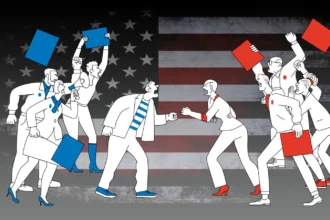The False Dichotomy of Violence and Nonviolence in Climate Action
The concept of nonviolence has long been held as the moral and strategic compass for climate activism. It’s easy to see why. Nonviolent protests, from the Civil Rights Movement to anti-nuclear demonstrations, have historically proved potent in galvanizing public support. Yet, in the battle against climate change, the conventional wisdom that pits violent against nonviolent action falls short of capturing the complexity of the issue at hand.
When it comes to climate action, the violence-nonviolence binary is overly reductive. It narrows the conversation to a moral litmus test, neglecting a host of other factors that contribute to the effectiveness of an activist strategy. It fails to consider, for example, that society’s dependence on carbon-intensive lifestyles itself constitutes a form of ‘slow violence’ on the environment and marginalized communities.
More crucially, by strictly adhering to nonviolent tactics, the climate movement might be unwittingly confining itself to a limited set of tools and strategies. This self-imposed limitation could hinder the movement’s ability to adapt and innovate in response to the rapidly escalating crisis. For instance, what would ‘violence reduction’ look like among those who lead carbon-intensive lifestyles? Could a degree of forcefulness be necessary to challenge the status quo and promote systemic change?
Therefore, breaking the violence-nonviolence binary isn’t just a matter of ethical recalibration; it’s a strategic imperative. By transcending this dichotomy, we create room for a more nuanced, flexible, and potentially effective activism that’s commensurate with the unprecedented challenges posed by climate change.
Consensus Around Nonviolence: Time for Reevaluation?
For years, nonviolence has been the consensus in climate activism, largely seen as both ethical and effective. This ideology, rooted in historical movements that have successfully instigated change, has its merits but may be too one-dimensional for the multifaceted issue of climate change. In focusing solely on nonviolent action, we limit the strategies available to us.
Take, for example, the necessity for ‘violence reduction’ among those leading carbon-intensive lives. This could involve a radical restructuring of daily routines and comforts that some might interpret as a form of self-inflicted ‘violence’ or harshness. Challenging the systemic factors contributing to climate change may also require a more forceful approach, beyond passive resistance.
The emphasis on nonviolence, while ethically laudable, may need reevaluation to meet the complex, urgent challenges that climate change presents. Therefore, it’s crucial to open the dialogue and reconsider the violence-nonviolence binary to pave the way for innovative, adaptive strategies for climate action.
Violence as a War, Not Metaphor
Climate change confronts us not as a metaphorical battle but as an actual war, with far-reaching consequences for human societies and the natural world. It’s a fight that transcends political boundaries, affecting communities and ecosystems alike.
This recognition should serve as a foundational shift in our approach to combating climate change. Traditional tactics, such as nonviolent protests and lobbying, may not be sufficient in this new paradigm. Acknowledging the ‘war-like’ state of this struggle could unlock alternative strategies, potentially incorporating both violence and nonviolence.
This doesn’t mean endorsing harmful actions but rather considering a broader spectrum of strategies to prevent climate catastrophe. When understood as a war, the urgency and diversity of tactics become clear, allowing for a more nuanced and effective resistance.
Therefore, it’s essential to see this fight for what it truly is, not as a choice between two simplistic options, but as a complex war demanding a multifaceted response.
What Is At Stake: Defining Territories
In the ongoing war against climate change, defining territories is crucial for strategic planning. This is not just about geographical boundaries but also involves delineating what aspects of life and the environment need safeguarding. What kind of life do we envision for ourselves and future generations?
We need a revolution not just in actions but also in thought.
What threatens this vision? Addressing these questions helps prioritize actions, whether it’s protecting natural habitats or reducing carbon footprints. Additionally, recognizing the significant role natural agents—such as forests, oceans, and biodiversity—play in shaping our societies is vital. These natural systems often exert more influence on human life than we acknowledge, from regulating climate to providing resources.
Thus, our territorial definitions must be broad and encompassing, covering both the human and non-human factors that influence societal development. By doing so, we create a more holistic strategy, acknowledging that this war is fought not just in the streets or legislative halls but also in the ecosystems that sustain us.
The Role of Natural Agents: Beyond the Human-Centric View
Incorporating natural agents like forests, oceans, and animals into our political discourse may appear unconventional but it’s far from absurd. Doing so can radically transform our approach to climate activism. By acknowledging that these agents often exert a greater influence on our societies than human interventions do, we can craft more comprehensive strategies.
This broader understanding breaks free from the limiting violence-nonviolence binary and allows for multi-pronged tactics. In essence, natural agents can become partners in our fight against climate change, prompting us to explore both violent and nonviolent means of securing their protection and thus our survival.
The climate crisis has hit marginalized communities hardest, making their fight a desperate one. The conversation about the potential legitimacy of violent actions in these contexts is thus not entirely unfounded. To dismiss this out of hand as unethical or ineffective would be to oversimplify a complex issue. Instead, opening up a dialogue about the strategic use of violence, particularly for these communities, can deepen our understanding of what’s truly at stake and potentially offer more effective pathways for activism.
The violence here is not gratuitous but a possible last resort, deployed under dire circumstances. By examining this alongside other tactics, we can foster a more nuanced, effective, and inclusive climate movement.
A reevaluation of the violence-nonviolence binary
The notion that violence can serve as a form of prevention is undoubtedly controversial, but it deserves critical scrutiny. If employing calculated violence could sustain a world that remains habitable for both humans and other species, wouldn’t it be worth exploring? Imagine a scenario where nonviolent protests fail to bring about the needed changes, pushing us further into climatic chaos.
In this context, the broader violence and suffering caused by uncontrolled climate change could far surpass the controlled, strategic violence used to mitigate it. Thus, embracing such a strategy might not just be a ‘necessary evil,’ but a more humane option in the grand scheme of things.
Therefore, dismissing the potential role of violence out of moral absolutism could be more detrimental. Instead, we need to explore every available avenue, balancing ethical considerations with the urgent reality. While nonviolence remains the preferable first option, the concept of violence as prevention should not be ignored.
It could be the lesser of two evils, aimed at averting a greater catastrophe. In summary, a reevaluation of the violence-nonviolence binary, with a willingness to consider the former as a form of prevention, may be essential for effective climate action.
Conclusion: Towards a Hybrid Strategy for Climate Action
As the climate crisis escalates, the urgency to act grows proportionally. While nonviolence has been the predominant strategy, it may not suffice as the sole approach. A hybrid strategy, one that breaks the conventional violence-nonviolence binary, offers a pathway for more effective climate action.
This new framework could include elements like violence reduction, especially among privileged, carbon-intensive lifestyles, and the strategic use of violence under specific conditions. Also, it would involve defining what territories—both ecological and conceptual—we need to preserve to ensure a sustainable future.
Including natural agents in the equation provides a holistic view of the ecosystem we aim to protect. Recognizing the role of marginalized communities and their potential legitimacy in using violence offers depth to our strategic toolkit. Opening the door to this hybrid approach isn’t a call to arms but a call for a broader, more nuanced dialogue. As we face an existential crisis, restricting ourselves to outdated paradigms could be perilous.
We need a revolution not just in actions but also in thought. Challenging the established binary between violence and nonviolence may be the vital first step in crafting a more effective, encompassing strategy for climate action.
Adapted from an academic article for a wider audience, under license CC BY 4.0














